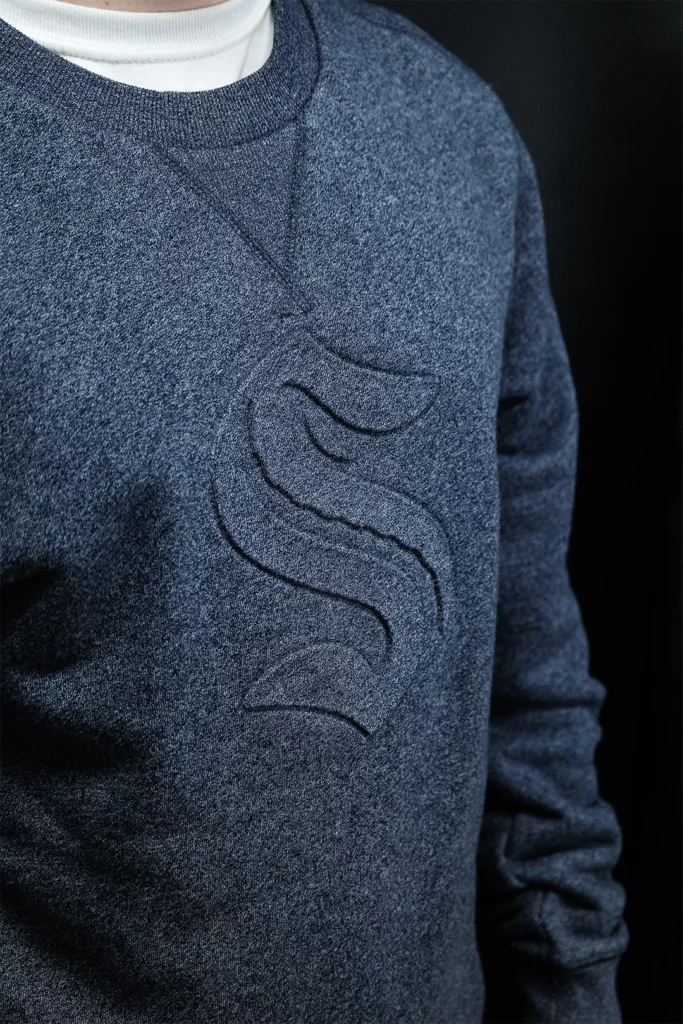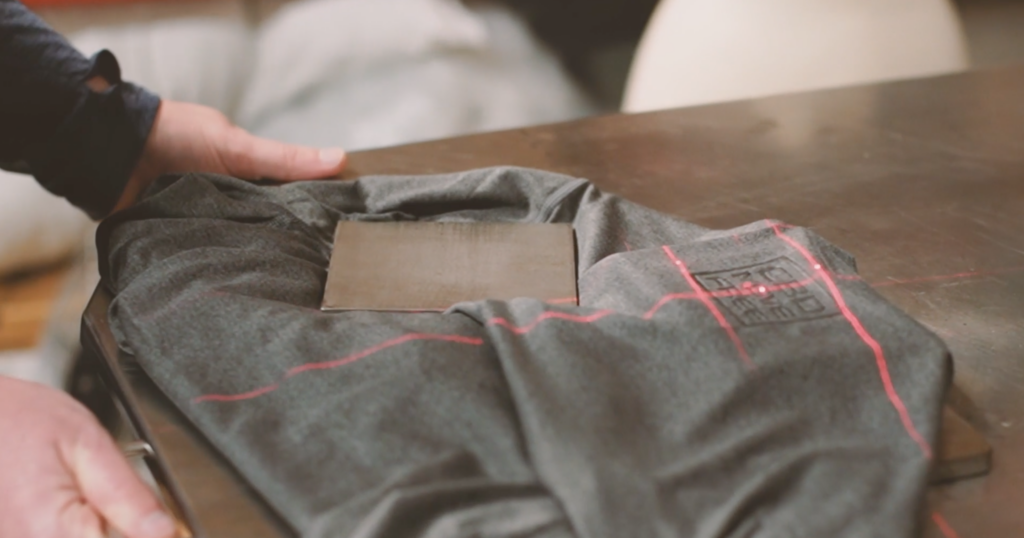
Enter the world of embossing and debossing – two powerful techniques that bring a new dimension to custom apparel.
In the dynamic world of branded merchandise, the quest for distinctive and memorable custom clothing has led to innovative branding techniques that leave a lasting impression.
Standing out is about more than just bold designs and vibrant colors. It’s about creating an experience, a tangible connection that resonates with your audience.
While they might sound similar, each technique offers a distinct way to define your brand’s presence in the crowded marketplace.
But what sets these techniques apart, and how can they transform your branded apparel into a tactile experience?
This comprehensive guide delves deep into the heart of embossing and debossing. It will shed light on their unique characteristics, applications, and impact they can have on your branded merchandise.
As we explore embossing and debossing in branded clothing, we’ll delve into materials, design considerations, and trends in branded apparel.
Whether you’re a fashion startup looking to make a mark, a corporate entity seeking innovative promotional items, or a designer aiming for the next level of customization, understanding these techniques is crucial.
Join us as we unravel the secrets behind these captivating branding methods. We will provide you with the knowledge and inspiration to choose the right technique for your branded merchandise.
Discover how embossing and debossing can not only enhance the aesthetic appeal of your custom clothing but also strengthen your brand’s identity and connection with your audience.
What is Embossing?
Embossing is a process that creates a raised design or pattern on the surface of a material. This is achieved by pressing a metal die with the desired design into the fabric under high pressure and heat.
The result is a three-dimensional effect that adds texture and visual interest to the garment. Embossing is particularly effective on thicker materials where the raised design can be more pronounced.

Applications in Branded Clothing
Leather Jackets: Embossed logos on leather jackets can elevate the garment’s luxury feel, making it a premium choice for high-end branded merchandise.
Polo Shirts: Subtle embossing on polo shirts can add an exclusive touch without overwhelming the garment’s design.
Sweatshirts and Hoodies: A debossed logo on the chest or sleeve of a sweatshirt or hoodie offers a subtle branding element that is both tactile and visually appealing.
Caps: Embossed details on caps, especially on the visor or the front panel, can create a distinctive look.
Leather Accessories: Embossing on leather bags, belts, or wristbands adds a luxurious and custom touch.
High-End Handbags: A subtle embossed logo or pattern on leather handbags elevates the brand’s prestige.
Denim: Embossing a logo or design on denim jackets or jeans pockets for a unique branding element.
Hats and Caps: Leather patches on hats can be embossed with a logo or design, adding a premium feel.
Footwear: Leather shoes and boots can have embossed details, such as logos on the tongue or heel.
What is Debossing?
Debossing, on the other hand, is the opposite of embossing. Instead of creating a raised design, debossing presses the design into the surface of the material, resulting in an indented pattern.
Like embossing, debossing uses a metal die and high pressure, with or without heat, to create the design. The debossed area can be left untouched or filled with ink to add contrast and make the design more visible.
Debossing Clothing and Accessories
Leather Goods: Debossing offers a subtle, sophisticated branding method for leather goods.
Athletic Apparel: Debossed logos on performance fabric for a sleek, modern look on sportswear.
Outerwear: High-quality jackets with debossed logos on leather patches or directly on the fabric.
Canvas Tote Bags: Debossed logos or designs on canvas bags for a durable and stylish promotional item.
Sweatshirts and Hoodies: A debossed logo on the chest or sleeve of a sweatshirt or hoodie offers a subtle branding element that is both tactile and visually appealing.
Backpacks: Debossing can be used on leather patches or directly on the fabric of backpacks for a sophisticated branding solution.
Embossing and Debossing: Choosing the Right Technique for Your Brand
The choice between embossing and debossing depends on several factors, including the material of your clothing, the desired aesthetic, and the message you want to convey with your brand.
These techniques offer a tactile experience that can make your merchandise more memorable and desirable. Here are some considerations to help you decide:
Combine Techniques
For brands looking to make a bold statement, combining embossing and debossing within the same piece offers an innovative way to create textural contrasts that catch the eye and invite touch.
This dual technique can be particularly effective on larger items like leather bags, jackets, or even high-quality notebooks. In these items the interplay of raised and indented surfaces can add depth and interest to the product.
By carefully selecting areas for each technique based on the design and material, brands can craft unique pieces that stand out in a crowded market.
Quality Matters
The success of embossing and debossing techniques heavily relies on the precision of the die used and the quality of the material. Imperfections in the die or inconsistencies in the material can lead to blurred or uneven designs that detract from the overall quality of the merchandise.
Therefore, partnering with a reputable manufacturer who understands the intricacies of these techniques and maintains high-quality standards is crucial.
At Logo Unlimited we have a proven track record of excellence in embossed and debossed merchandise.
Material Considerations
While leather and heavy cotton are traditionally favored for embossing and debossing due to their durability and texture, innovative materials like silicone, dense foam, and certain synthetic fabrics can also provide excellent results.
When selecting materials for your merchandise, consider how the texture, density, and wearability will interact with the embossing and debossing. This will ensure your design remains crisp and visible over time.
Materials that age well, like high-quality leather, can add character to the embossed or debossed design as the product matures.
Thicker, more pliable materials like leather and heavy cotton are suitable for both techniques, but the final effect will differ.
Brand Aesthetic
Embossing exudes a sense of luxury, sophistication, and exclusivity, making it a perfect choice for premium brands looking to emphasize their high-end appeal. It adds a tactile dimension that can elevate the perceived value of the product.
Conversely, debossing offers a more subtle, modern aesthetic. Its indented design integrates seamlessly with the product. This provides a sleek and contemporary look that appeals to brands with a minimalist identity.
This choice hinges on various factors, including material compatibility, brand aesthetic, and the durability of the design. Understanding these elements is crucial for brands aiming to make an informed decision that aligns with their marketing strategy and brand values.
Visibility and Wear
The durability of your design and its visibility over time are critical considerations. Both embossing and debossing offer unique advantages in terms of wear.
Embossed designs, being raised from the surface, may be more susceptible to wear and tear, especially on frequently used items like wallets or belts. However, this technique can also create shadows and highlights that enhance visibility from various angles.
Debossed designs, being recessed, are protected from direct contact and abrasion, potentially extending the lifespan of the branding. Yet, the visibility of debossed designs might be more angle-dependent, requiring strategic placement to ensure maximum impact.
Assessing how the design will age with the product and remain visible under different conditions is essential for maintaining brand recognition.
Keep It Subtle
The beauty of embossing and debossing lies in their subtlety. A minimalist approach often yields the most elegant results. Their ability to transform a simple piece of clothing or accessory into something truly special without overwhelming the design.
A minimalist approach, focusing on small, strategic placements of your logo or design, can yield incredibly elegant and impactful results.
This subtlety ensures the branding enhances rather than detracts from the overall design, making it more appealing to consumers.
Final Thoughts on Embossing and Debossing
Embossing and debossing go beyond traditional branding techniques, emerging as art forms that infuse custom clothing and accessories with unparalleled depth, texture, and character.
These methods are pivotal in crafting a distinctive brand identity that resonates deeply with your target audience.
Tactile experience, combined with visual appeal, ensures that your branded merchandise leaves a lasting impression.
By integrating embossing or debossing into your product design, you’re not merely adding a logo; you’re crafting an interactive brand experience that can be felt in the literal sense.
Every brand has a story, and how you tell that story through your merchandise can set you apart. Embossing and debossing allow for a nuanced expression of your brand’s ethos, values, and personality.
Whether you aim to convey luxury and sophistication or modernity and innovation, these techniques can be tailored to reflect your narrative in a way that speaks volumes.
Your Brand, Your Way
The choice of embossing or debossing, the materials selected, and the design’s placement all contribute to the storytelling process, making your branded merchandise a key chapter in your brand’s story.
As we look to the future, the role of innovative branding techniques like embossing and debossing in creating meaningful connections with consumers will only grow.
Brands that leverage these techniques effectively will not only capture the attention of their audience but also inspire loyalty and advocacy.
The key to success lies in thoughtful design, quality execution, and a clear understanding of how these tactile elements can enhance your brand narrative.
By carefully selecting the right method, you can create products that not only make a visual impact but also forge a tactile connection with your audience.
In the world of custom merch it’s the attention to detail and the pursuit of excellence that will set your brand apart.
